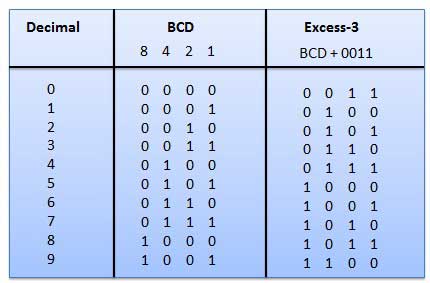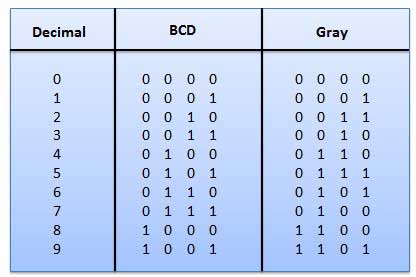Binary Codes
Which are the binary codes?
In the coding, when numbers, letters or words are represented by a selected institution of symbols, it's miles said that the quantity, letter or word is being encoded. The organization of symbols is referred to as as a code. The digital records is represented, saved and transmitted as organization of binary bits. This institution is also referred to as as binary code. The binary code is represented by means of the number in addition to alphanumeric letter.
Advantages of Binary Code
Following is the list of benefits that binary code gives.
Binary codes are suitable for the computer packages.
Binary codes are appropriate for the virtual communications.
Binary codes make the analysis and designing of virtual circuits if we use the binary codes.
Since simplest zero & 1 are being used, implementation turns into clean.
Classification of binary codes
The codes are widely categorized into following four categories.
Example

Weighted Codes
Non-Weighted Codes
Binary Coded Decimal Code
Alphanumeric Codes
Error Detecting Codes
Error Correcting Codes
Weighted Codes
Weighted binary codes are those binary codes which obey the positional weight principle. Each position of the wide variety represents a specific weight. Several systems of the codes are used to specific the decimal digits zero through nine. In these codes every decimal digit is represented with the aid of a group of four bits.

Weighted Code
Non-Weighted Codes
In this sort of binary codes, the positional weights are not assigned. The examples of non-weighted codes are Excess-3 code and Gray code.
Excess-three code
The Excess-3 code is also known as as XS-three code. It is non-weighted code used to specific decimal numbers. The Excess-three code words are derived from the 8421 BCD code words adding (0011)2 or (3)10 to each code phrase in 8421. The excess-3 codes are acquired as follows −
Excess-3 code
Example
BCD to Excess-three code

Gray Code
It is the non-weighted code and it isn't always mathematics codes. That approach there are no unique weights assigned to the bit role. It has a completely unique characteristic that, best one bit will alternate whenever the decimal wide variety is incremented as shown in fig. As handiest one bit changes at a time, the gray code is known as as a unit distance code. The gray code is a cyclic code. Gray code cannot be used for arithmetic operation.
Gray code
Application of Gray code
Gray code is popularly used in the shaft role encoders.
A shaft position encoder produces a code word which represents the angular position of the shaft.
Binary Coded Decimal (BCD) code
In this code each decimal digit is represented by means of a four-bit binary range. BCD is a manner to express each of the decimal digits with a binary code. In the BCD, with 4 bits we can constitute 16 numbers (0000 to 1111). But in BCD code only first ten of those are used (0000 to 1001). The final six code combos i.E. 1010 to 1111 are invalid in BCD.
BCD code
Advantages of BCD Codes
It may be very much like decimal system.
We want to don't forget binary equivalent of decimal numbers zero to 9 most effective.
Disadvantages of BCD Codes
The addition and subtraction of BCD have different guidelines.
The BCD mathematics is little extra complicated.
BCD needs greater wide variety of bits than binary to symbolize the decimal range. So BCD is less green than binary.
Alphanumeric codes
A binary digit or bit can constitute only symbols because it has best two states '0' or '1'. But this is not sufficient for communique among two computers because there we want many greater symbols for communique. These symbols are required to symbolize 26 alphabets with capital and small letters, numbers from 0 to nine, punctuation marks and other symbols.
The alphanumeric codes are the codes that represent numbers and alphabetic characters. Mostly such codes also represent different characters consisting of symbol and diverse commands vital for conveying information. An alphanumeric code need to as a minimum constitute 10 digits and 26 letters of alphabet i.E. Overall 36 objects. The following 3 alphanumeric codes are very usually used for the records illustration.
American Standard Code for Information Interchange (ASCII).
Extended Binary Coded Decimal Interchange Code (EBCDIC).
Five bit Baudot Code.
ASCII code is a 7-bit code while EBCDIC is an eight-bit code. ASCII code is greater usually used worldwide at the same time as EBCDIC is used usually in massive IBM computer systems.
Error Codes
There are binary code strategies available to come across and correct records at some stage in facts transmission.
Error Code Description
Error Detection and Correction
Error de


0 Comments